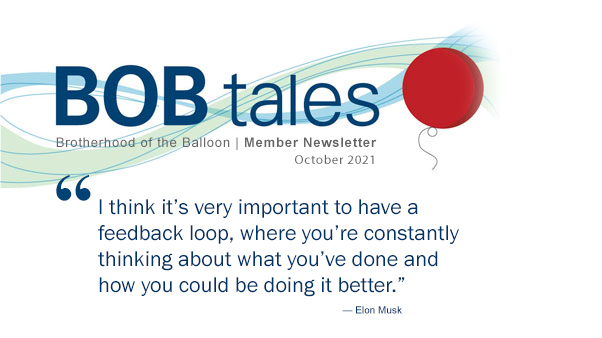
Dear Members (a note from Deb Hickey):
I had to literally tie my hands together to achieve my goal of shortening the opening memo this month. It’s hard to type, but I’ve succeeded.
We send you a 20+-page journal every month. And for the past 10 years that I’ve been working alongside my father Bob Marckini, I can’t quite figure out how or why we can’t stop writing. I used to scold him for his three-page introductory letters. But alas! I’ve been doing the same thing.
I hear from hundreds of members following the distribution of the BOB Tales. Second to answering the brain teasers, most of you comment on the opening memo – a personal story I’ve shared, usually. And I’ve gone back and forth with several of you … for days, weeks, years even. I’ve developed real friendships over email! What a gift!
But this month, I’m changing things up. I’m wondering – how do you feel about our opening memos? The length of our newsletters? And of course, we want to know what you think of the content. Please send your thoughts and ideas to me at [email protected]. Maybe I’ll share some of the feedback in our November issue.
Happy Autumn, everyone!
This month we cover the broader acceptance of focal therapy for prostate cancer, which could become common practice within the next five years. We also report on advancements in live imaging in proton therapy and the potential for this technology to be available soon. And we’re excited to report that last month was the first time we’ve seen published findings that demonstrate the feasibility of using protons rather than electrons in flash therapy, which can deliver an entire course of radiation treatment in under one second!
Loma Linda University Health recently unveiled a new state-of-the-art adult hospital and children’s hospital tower expansion thanks to extremely generous patient donations, including those of many of our members. We write about the importance of maintaining a healthy brain – and how to do so – as we age. And we share the many benefits of eating certain types of nuts. And there’s so much more!
We hope you enjoy the BOB Tales. And like I mentioned, we welcome and encourage your feedback. Please send an email to [email protected].
Deb Hickey
To print the BOB Tales newsletter or view the newsletter with a larger font size, click here for the PDF file. .jpg)
.jpg)
In This Issue:
- Focal Therapy for Prostate Cancer in Next Five Years
- One Step Closer to Live Imaging in Proton Therapy
- Flash Therapy to Treat Cancer in Milliseconds
- Diet May Help Therapies
Target Cancer Cells - LLUH New Medical Campus Opens
- Maintain a Healthy Brain: Simple Things You Can Do to Help Keep It Working at Its Very Best
- Go Nuts This Year: The Numerous Benefits of Nuts


.jpg)
Focal Therapy for Prostate Cancer in Next Five Years
The journal JAMA Surgery reported, on July 18, 2021, that within the next five years we can expect “routine application” and “broader acceptance” of minimally invasive focal therapies for early-stage prostate cancer in the U.S.
In some respects, focal therapy can be considered the “middle ground” between active surveillance and whole gland treatment, such as surgery or radiation. Focal therapy can be used to treat the primary lesion(s) while leaving the remainder of the prostate intact. This suggests that the significant side-effects that often result from whole-gland treatment can likely be avoided, or, at the very least, minimized.
Types of Focal Therapies
There are many types of focal therapy including proton therapy, focal laser ablation, focal brachytherapy, focal HIFU (high intensity focused ultrasound), focal cryoablation, and transurethral ultrasound ablation.
At the time of this writing, focal therapy doesn’t have universal acceptance. Continued research is under way and supporting evidence is being generated that could bring this technology to routine practice in the not-too-distant future.
It should be noted that focal treatments have recently been used to deal with prostate cancer recurrences where a small number of lesions can be detected using some of the newer, advanced imaging technologies discussed in previous BOB Tales newsletters.
For now, at least, only early-stage prostate cancer is being considered as part of this study for routine focal treatment..jpg)
.jpg)
.jpg)
One Step Closer to Live Imaging in Proton Therapy
Researchers at HZDR Institute of Radiooncology in Dresden, Germany are planning to build a prototype that tracks moving tumors with magnetic resonance imaging (MRI) in real time during proton therapy treatment. They’re combining a rotating open MRI device (different than the cylindrical structure and designed for patient comfort for those who are claustrophobic) with an actively scanned proton beam.
Although standard proton therapy treatment delivers a highly-targeted dose of radiation to the tumor while sparing surrounding healthy tissue, the precision targeting can be compromised by tumor motion, for example, during respiration or digestion, throughout the course of treatment. Real-time imaging, however, could visualize the tumor and synchronize the proton beam to its motion.
“MR-integrated proton therapy will have the capability to capture anatomical changes during therapy and allow for treatment adaptations to increase the targeting precision and reduce normal-tissue side effects,” said Dr. Aswin Hoffmann, medical physicist and research leader.
The team hopes to have the system up and running next summer.
.jpg)
Flash Therapy to Treat Cancer in Milliseconds
We’ve written about flash radiation therapy several times in our NAPT conference recaps as the technology has been evolving over the past few years. This is the first time we’ve seen published findings, and that can only be a good thing!
Flash therapy involves radiation treatment of tumors at ultra-high dose-rates, which reduces normal tissue toxicity while maintaining the effectiveness of conventional radiotherapy. Flash therapy could revolutionize how cancer patients are treated, allowing them to receive an entire course of radiation therapy in less than a second, thereby shortening the time they spend in treatment and improve overall outcomes.
Flash Therapy with Protons
Typically, flash therapy works by bombarding the tumor site with a steady stream of particles, usually photons or negatively charged electrons. However, scientists are now adding another particle into the mix – the positively charged proton.
“This is the first time anyone has published findings that demonstrate the feasibility of using protons rather than electrons to generate flash doses, with an accelerator currently used for clinical treatments,” explained the study’s co-senior author James M. Metz, Chairman of Radiation Oncology at the Perelman School of Medicine.
Using protons in flash therapy is considered a breakthrough as other researchers have failed to generate the necessary dosage because the high levels of radiation required to deliver the treatment rapidly saturate radiation detectors.
“We’ve been able to develop specialized systems in the research room to generate flash doses, demonstrate that we can control the proton beam, and perform a large number of experiments to help us understand the implications of flash radiation that we simply could not have done with a more traditional research setup,” Metz said.
Researchers are already optimizing how they’ll use their techniques in clinical trials. If flash therapy gets the go-ahead from medical authorities, it could be widely available to patients in the future.

We’ve been producing BOB Tales newsletters monthly for more than 20 years. During this time there have been articles that many new members haven’t seen, and some older members may have forgotten. So, we periodically re-run articles from past newsletters. The following is from August 2006.
Diet May Help Therapies Target Cancer Cells
In a series of recently published papers, Gilda Hillman, Ph.D. has shown that under certain conditions, soy makes prostate cancer cells more sensitive to radiation therapy by inhibiting
cell survival pathways activated by radiation. Researchers have hypothesized that soy isoflavones could be useful when given in conjunction with curative radiation therapy in patients with localized prostate cancer. These isoflavones appear to have the potential to both enhance the efficacy of radiation therapy as well as help prevent the adverse effects of radiation such as urinary, intestinal, and sexual function changes.
Dr. Hillman is part of a growing movement of scientists investigating how dietary factors might improve the treatment of cancer. Many researchers are investigating how specific changes such as adding soy, garlic, fish oil, or other foods to the diet may make it easier for conventional cancer therapies to target cancer cells, rendering treatment safer and more effective. It appears that specific foods or food components have the potential to make cancer cells more radiosensitive (susceptible to radiation) or chemosensitive (susceptible to chemotherapy).

LLUH New Medical Campus Opens

Last month, Loma Linda University Health officially opened the Dennis and Carol Troesh Medical Campus, home to a state-of-the-art adult hospital and children’s hospital tower expansion. LLUH staff, patients, and friends celebrated with a joyous ribbon-cutting ceremony.
The new campus was made possible in part by the philanthropy efforts of Vision 2020 – The Campaign for a Whole Tomorrow. Philanthropists Dennis and Carol Troesh generously donated the lead gift of $100 million to the initiative.
“This is truly a historic day in the legacy of Loma Linda University Health,” said Richard Hart, MD, DrPH, president of Loma Linda University Health during the ribbon-cutting. “There are no words to adequately express the sincere gratitude and excitement that we feel as we open these doors to the community.”
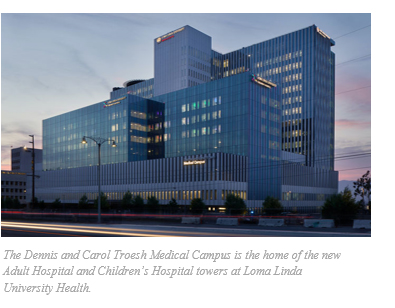 During the ribbon cutting ceremony, Kerry Heinrich, CEO of LLUH, reflected on the Seventh-day Adventist legacy of the organization, highlighting LLUH’s co-founder Ellen White arriving to the area in 1905 and remarking, “this is the very place” that would be used to bring hope and healing. The new campus, Heinrich said, begins a new chapter in that legacy.
During the ribbon cutting ceremony, Kerry Heinrich, CEO of LLUH, reflected on the Seventh-day Adventist legacy of the organization, highlighting LLUH’s co-founder Ellen White arriving to the area in 1905 and remarking, “this is the very place” that would be used to bring hope and healing. The new campus, Heinrich said, begins a new chapter in that legacy.

► BOB Comment: Thank you to all our members and friends who made contributions to Vision 2020 over the past few years. You are a part of this new chapter! And a very special thank you to BOB Member, and our good friend, Chuck Kubicki, for the one million dollar check he gave to Bob Marckini to present to Dr. Hart for Vision 2020 in December 2016.

.jpg)
Giving Options
- Donate to proton research online.
- Write a check to LLUCC Proton (Put “Marckini Chair” on the memo line) and mail to LLUH, Office of Philanthropy P.O. Box 2000, Loma Linda, CA 92354.
- Make an unrestricted gift (put “unrestricted” on memo line) so LLUH can use it where it’s needed most.
- Call Regina Joseph at 909-558-5010 to donate over the phone.
.jpg)
.jpg)
.jpg)
Still Available!
In an effort to boost funding for basic and clinical proton therapy research on prostate cancer, pancreatic cancer, liver cancer, breast cancer, and more, we asked our members to donate $100 (or more) to Loma Linda University Cancer Center. In return, they’d receive an advance copy of Dr. William Preston’s book, Don’t Just Stand There – Realizing a Vision for Proton Therapy: Conversations with James M. Slater, MD, FACR. The response so far has been phenomenal. Thank you to all who’ve requested a copy.
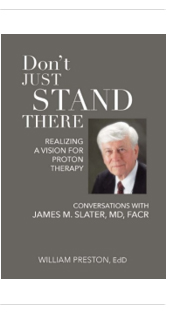 If you’d like a pre-published copy of “Don’t Just Stand There,” please send a check for $100 or more, payable to “Loma Linda University Proton Cancer Research” and mail it to:
If you’d like a pre-published copy of “Don’t Just Stand There,” please send a check for $100 or more, payable to “Loma Linda University Proton Cancer Research” and mail it to:
Loma Linda University Health ● Office of Philanthropy ● PO Box 2000 ● Loma Linda, CA 92354
Please notify Deb Hickey at [email protected] that you’ve sent in your check and your book will be mailed immediately.
This book, which contains high-quality color images and illustrations, is not only about Dr. Slater’s quest to create the world’s first hospital-based proton treatment center, it’s also a teaching guide. As the Proton Treatment & Research Center at Loma Linda was such an immense endeavor, Dr. Slater wondered if the aspects of conceiving, planning, and orchestrating such a project, among others he undertook, might be instructive to others. Over the years, he’d also met people in all walks of life, many of whom had dealt with large and complex problems. He was struck by some of the stories they told about their work. And although the fields or disciplines usually had nothing to do with medicine, many experiences were similar. And so, he kept this in mind while he worked on the book with Dr. Preston.
We’re sure you’ll thoroughly enjoy the book and we know it will occupy a place of honor
in your home. And, you’ll be helping to fund basic and clinical proton research on prostate cancer, pancreatic cancer, liver cancer, breast cancer, and much more with your tax-deductible gift. Thank you!

Maintain a Healthy Brain
Dr. Mike Dow, a psychotherapist and best-selling author, reports that aging has long been associated with a slow mental decline. The good news is there are simple things you can do to regain your focus. Dr. Dow recommends you give yourself daily brain challenges. “Every time you learn something new, or play a challenging game or read a book, it’s like depositing a dollar into a savings account. The more deposits you make, the more you have to spare,” he says.
“The brain is just like the heart, our muscles, our lungs, and bones,” he says, “It needs maintenance and healthy habits to help keep it working at its very best.”
Here’s a list of brain exercises from Forbes. They include varieties of puzzles, knitting, and even dancing!
Dr. Dow also suggests you feed your brain the right food such as an antioxidant-rich diet including unsweetened tea, berries, and turmeric. He also reminds us to get enough sleep, which he refers to as the “wash-and-rinse cycle” that clears away the “bad stuff” that builds up during the day. “Brain fog and dementia-causing plaques are washed away by cerebrospinal fluid, and this process is more effective when you’re sleeping.” Dr. Dow suggests we strive for eight hours of sleep each night, and if you have difficulty getting to sleep, he recommends melatonin instead of prescription and over-the counter sleep aids.
.jpg)
Go Nuts This Year
Nuts can help fight the onset of diseases, says Dr. Mike Roussell, a nutrition consultant. He particularly recommends pistachios with their fiber, healthful fats, and loads of antioxidants, which can protect you from damaging UV light. “Nuts can lower your risk of heart attack, promote weight maintenance, and help with digestion,” Dr. Roussell says.
He lists studies that show numerous benefits for heart health, anti-inflammatory effects, weight loss, digestion, blood glucose level, skin health, eyesight, memory, sleep, and energy level. Nuts can provide a terrific boost for your health.
And, pistachios taste good, he tells us. “People are much more likely to stick to a healthful diet when the food is tasty and fun to eat.”
Dr. Roussell’s article, “10 Reasons to go Nuts for Pistacios” was published in FiftyPlusLife.

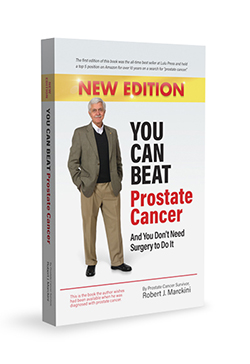 You Can Beat Prostate Cancer: And You Don’t Need Surgery to Do It – Second Edition
You Can Beat Prostate Cancer: And You Don’t Need Surgery to Do It – Second Edition
We routinely hear from readers about how profoundly helpful and informative they found Bob’s new book. One of the most important chapters in the new book is 18, “Ten Steps for Taking Control of the Detection and Treatment of Your Prostate Cancer.”
Over the next few months, we plan to feature excerpts from this important chapter, hoping it will provide valuable information to members, and especially to their family and friends.
The opening quote puts the theme of the chapter in proper perspective: “Your life will fly by, so make sure you’re the pilot.” – Rob Liano. As Bob states, “Perhaps the most important message in this book is ..
You are in charge of your health, and … You should take control of your health.
This is especially important when dealing with prostate cancer. Starting with the diagnostic process all the way through to the treatment decision there is significant confusion, fueled by major differences of opinion among medical professionals and institutions. If you just do what your primary care physician or urologist suggests, you won’t necessarily be making the best decision for you.
Bob feels that if you follow the 10 steps he outlines, you’ll greatly increase your chances of catching the disease early. The earlier prostate cancer is detected, the easier it is to cure. Equally as important, once diagnosed, there are several things you can do that will virtually guarantee you make the treatment decision that will give you the best chance of a cure as well as a high quality of life after treatment. Here is the first of the 10 steps:
1. Choose Your Doctors Wisely
Primary Care Physician
 This is your first line of defense. Almost all prostate cancers are discovered as a result of action by the patient’s family doctor. Too often cancer is discovered after it has progressed well beyond the early stage because the patient’s doctor was not knowledgeable or didn’t recognize the early signs of prostate cancer.
This is your first line of defense. Almost all prostate cancers are discovered as a result of action by the patient’s family doctor. Too often cancer is discovered after it has progressed well beyond the early stage because the patient’s doctor was not knowledgeable or didn’t recognize the early signs of prostate cancer.
Many people choose a primary care doctor who’s close to their home or office. Others move into a new neighborhood and make their choice based on a neighbor’s recommendation. That may be a good start, but you should then meet with the doctor and conduct an interview to ensure that he or she is best for you.
My primary care physician’s office is an hour and a half drive from my home. There are literally hundreds of doctors closer to where I live. I chose this physician for the following reasons:
.jpg)
- He’s bright and personable.
- He spends time with his patients, carefully and thoughtfully answering all their questions. I’m never rushed through an annual physical or an office visit.
- He returns telephone calls within a reasonable time period.
- His specialty is gastroenterology, which is important to me, as both my parents and my sister had colon cancer, and this is another disease where heredity and early detection are critical factors.
- He has performed hundreds of colonoscopies, the most important early detection test for colon cancer.
- He understands the early signs of prostate cancer and is responsive to rising PSA.
- He keeps abreast of new developments in medicine.
- He is “proton friendly” and has recommended proton therapy to his patients.
- He came highly recommended by a doctor friend, whose opinion I value.
.jpg)
To me, it’s worth the long drive to have the best medical care. If there were an emergency, I’d go to my local hospital emergency room. For everything else, I make the 1½-hour drive.
The principal function of your primary care physician should be health protection and proactive disease prevention. Good doctors won’t wait for the telltale symptoms of a medical disorder to show up. They’ll use all the information available to them – physical examinations, routine medical tests, and discussions with their patients – to probe for the earliest signs of a health problem.
Your automobile engine will run longer and smoother if you ensure the crankcase oil is clean and filled to the proper level and if you take other appropriate preventive maintenance measures. Waiting for the engine to “send you a signal” that something is wrong might be too late; the damage may already be done – and it may be irreversible.
Know your doctor’s opinion of the PSA test. Many physicians believe that because PSA is a non-specific test for prostate cancer, a high or rising number isn’t cause for alarm. Or they may feel PSA is of no concern until it progresses beyond the “normal” range. In both cases there may not be cause for alarm, but there is cause for concern and action. This is discussed in the next steps.
Most of us don’t see a urologist until a problem is detected or suspected. So, your family doctor or primary care physician is your first line of defense against prostate cancer. Choose him or her wisely.
Proof of His/Her Competency
One side-story on my primary care doctor: My son-in-law was experiencing stomach pain over a two-week period. He visited his own doctor several times during that time and was told it was probably a stomach bug. When it persisted, his doctor prescribed an antibiotic, suggesting it could even be a parasite.
For days thereafter, as my son-in-law was still in pain, I suggested he meet with my primary care physician. Within three days, my doctor diagnosed him with advanced, metastatic, neuroendocrine carcinoma of the pancreas. Yes, advanced, metastatic pancreatic cancer, a devastating diagnosis with a terrible prognosis. Our lives were turned upside down.
What happened next was nothing short of a miracle. Through chemotherapy, diet changes, extraordinary care by my daughter, Deb, and tons of prayers, my son-in-law survived. Today, seven years later, there’s no evidence of cancer. Had my son-in-law gone another week undiagnosed, he likely would have died. My primary care doctor not only diagnosed the illness quickly, he also recommended the oncologist who directed his vigorous treatment program. That’s what a premier primary care physician can do.
Urologist
Sooner or later just about everyone, male or female, will need a urologist. Why wait until a problem develops? Why not do some homework and select your urologist before there’s a medical need? He/she might not be taking new patients when you need him/her the most. The best time to select a good urologist is when you don’t need one.
Most general practitioners are affiliated with a specific urologist and will typically refer their patients to this associate. That urologist may or may not be the best one for you.
If you have prostate cancer in your family, or if you have rising PSA, you should begin the search for a urologist at the earliest opportunity. Find out what doctors your friends and acquaintances use. Check their credentials. What hospital are they affiliated with? What is the reputation of that hospital? What technique do they use to take biopsy samples? How many biopsy core samples do they take? It should be a minimum of 12, preferably 20. Is a local anesthetic used during biopsy sampling?
Speak with patients who use the urologist you’re considering. Especially speak with patients who’ve had prostate biopsies done by this doctor.
Find out if the doctor uses an assistant while taking biopsy samples. This is essential if you want the procedure to be done quickly, efficiently, and with the least amount of discomfort.
Find out if this doctor ever recommends anything other than surgery for prostate cancer patients who are younger than 65. Most urologists will suggest other treatment alternatives or active surveillance for older patients who can’t tolerate the trauma of surgery, so the question is important: Does he/she ever recommend radiation, seeds, cryo, etc. to patients who are younger than 65?
You may not be able to find answers to all these questions but find out as much as you can. One service The Brotherhood of the Balloon provides its members is a list of “proton-friendly” urologists within the U.S. These are doctors who have treated BOB members and are considered excellent physicians with open minds on proton therapy.
► BOB Comment: The above comments on prostate biopsies refer to the standard, transrectal biopsy. Since this chapter was written more than a year ago, we’ve learned of exciting new developments in transperineal prostate biopsies, which we’ve written about in recent BOB Tales newsletters. In the next edition of Bob’s book, he’ll be covering that very important subject in detail.
Next month we’ll be writing about Step 2, “Have a PSA test and DRE as Part of Your Annual Physical and Track the Results.”
.jpg)
Here’s a recent Amazon review of Bob’s book:

The Best Prostate Information a Guy Could Hope For!!
I read Mr. Marckini's first edition while being evaluated for prostate cancer. Although my biopsy was negative and I was diagnosed with BPH, I wanted to be well prepared in the event cancer was on the horizon. EVERY man faced with a prostate issue who may need treatment must read this book. There’s now a second edition, which was published by Mr. Marckini in 2020. It’s a blockbuster and includes much more information than the first book. The two most important take aways for me: you have to be your own best advocate and you don’t have to have surgery for prostate cancer. Read the book. Do your due diligence and explore all that you can regarding proton therapy.
─ Anthony G. Smith, Major, USAF, Pediatric Nurse Practitioner, retired
.jpg)
Did you find Bob’s new book helpful?
Please write a review on Amazon.
We’re happy to discount books in quantity (minimum 20) to anyone interested in spreading the word on proton therapy. Just send an email to Deb Hickey. Proceeds from book sales are used to help fund our efforts and to support proton therapy research.
The Kindle version is free to Kindle Unlimited members or can be purchased for $9.99 for non-members. The paperback price is $22.45. Buy You Can Beat Prostate Cancer second edition on Amazon or Lulu Press.

Loma Linda Comes To You Virtually!
Dr. Richard Hart, president of Loma Linda Health is hosting an exclusive Loma Linda Comes to You virtual event on Wednesday, September 29, 2021. Get updates on the new, state-of-the-art hospital towers and how they’ll expand access to quality healthcare services for patients of all ages, incomes, and health disparities; and find out how LLUH’s pharmacy team has been involved in the COVID vaccine process.
To accommodate different time zones, LLUH has provided two meeting times. You’ll be able to submit questions in advance as well as during the meeting. Zoom registration is required.
Choose the time below that works best for you and click to register.
Wednesday, September 29 – 3:00 pm PST, 6:00 pm EST
Wednesday, September 29 – 6:00 pm PST, 9:00 pm EST
.jpg)
National Proton Conference
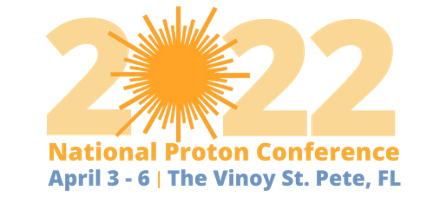 The National Association for Proton Therapy (NAPT) will be holding its next annual conference in St. Petersburg, FL, April 3-6, 2022. There will be two full days of in-person engagement, education, and collaboration among experts in the proton therapy world.
The National Association for Proton Therapy (NAPT) will be holding its next annual conference in St. Petersburg, FL, April 3-6, 2022. There will be two full days of in-person engagement, education, and collaboration among experts in the proton therapy world.
Exhibits: There are typically large halls filled with exhibits showing the latest developments in proton therapy technology, equipment, systems, and support systems. Information is presented on new particle accelerator design, new beam delivery systems, more precise control systems, and many things connected with proton therapy.
Attendance: Proton therapy centers from all over the world send representatives to the conference. Often clinicians and clinical leaders from all the major U.S. proton centers are in attendance, and many participate in panel discussions. Other attendees include physicists, senior administrative officials, and vendors who design and make equipment, products, and systems that support proton therapy and related technologies.
Panels and Presentations: Several presenters and panels will address a variety of proton-related issues ranging from the latest developments in proton therapy research, clinical and technological advances in proton therapy, global proton initiatives, and the economics and sustainability of proton center development and growth.



Last Month’s Brain Teaser
There is a word in the English language in which the first two letters signify a male, the first three letters signify a female, the first four signify a great man, and the whole word, a great woman. What is the word?
Answer: heroine
Winner: Mike Stolle of Fruita, CO is our brain teaser winner. He’s a new member and is scheduled to begin treatment at LLUCC shortly.
When we told Mike he was the winner, he wrote in an email to Deb, “I've only been
a member for a few weeks, but I already feel like part of the ‘family.’”
 During our correspondence, we learned that Mike is a “recovering engineer” just like Bob Marckini. He spent his working life as a Project Manager/Project Engineer for the Air Force both on active duty and as a government civilian employee. Mike retired in 2003. He’s been a private pilot for over 40 years and back in the 1980’s built his own airplane “that I flew all over the U.S.!”
During our correspondence, we learned that Mike is a “recovering engineer” just like Bob Marckini. He spent his working life as a Project Manager/Project Engineer for the Air Force both on active duty and as a government civilian employee. Mike retired in 2003. He’s been a private pilot for over 40 years and back in the 1980’s built his own airplane “that I flew all over the U.S.!”
When Deb asked Mike how he learned about proton therapy, he said, “I was fortunate to run across the website for Loma Linda Cancer Center when I was searching for prostate cancer treatment options.” From there, he requested a packet of information “still without quite knowing what proton therapy was.” When Mike received the package, he found a copy of Bob’s book enclosed. “I’m not an avid reader, but I read that book in about three evenings,” Mike said. “I was so glad to learn there were treatment alternatives that weren’t ‘barbaric’ in nature and had a much lower risk of side effects or later occurrences of secondary cancers.”
Mike’s urologist strongly recommended against proton therapy. “He’s no longer my urologist,” said Mike.
.jpg)
New Brain Teaser
I have a little house in which I live all alone. It has no doors or windows, and if I want to go out, I must break through the wall. What am I?
Send your brain teaser answer to [email protected] for a chance to win a signed copy of Bob Marckini’s NEW second edition book, You Can Beat Prostate Cancer.
.jpg)
Seniors and Technology (Source)
 Jimmy decided it was time for his mother to “get with the times,” so for her 80th birthday, he bought her a cell phone.
Jimmy decided it was time for his mother to “get with the times,” so for her 80th birthday, he bought her a cell phone.
Upon opening the gift, Mom is excited. Jimmy explains all the features and Mom says she loves it.
The next day, Mom goes shopping. Her phone rings and its Jimmy: “Hi Mom,” he says. “How do you like your new phone?”
Mom replies, “I just love it! It’s so small – it fits in my pocket! And your voice is clear as a bell! But there’s one thing I don’t understand though.”
“What’s that, Mom?” asks Jimmy.
“How did you know I was at Wal-mart?”
.jpg)
Near-Death Experience (Source)
A middle-aged woman had a heart attack and was taken to the hospital. While on the operating table, she had a near death experience. Seeing God, she asked, “Is my time up?” God said, “No – you have another 43 years, two months, and eight days to live.”
Upon recovery, the woman decided to stay in the hospital and have a nose job, face lift, and liposuction. Since she had so much more time to live, she figured she might as well look her best.
After her last operation, she was released from the hospital. While crossing the street on her way home, she was hit and killed by a bus.
Arriving in front of God at the pearly gates, she demanded, “I thought you said I had another 40-plus years?! Why didn’t you pull me out of the path of the bus?!”
God replied, “I’m sorry, I didn’t recognize you!”



Strange but True (Source)
After Death You Can Become an Ocean Reef. It’s true. A company, Eternal Reefs, can mix the cremated remains of a person with concrete to produce what they call a “pearl,” where loved ones can etch personal messages. The pearl is then inserted into a “reef ball” which is dropped into the sea to become a new habitat for fish and other sea life.
You Can Buy a Flying Bicycle. The XploreAir Parvelo is a folding bicycle that has a biofuel-powered fan motor. The motor powers the fan and airfoil. The flying bicycle can travel at 25 mph and reach altitudes of up to 4,000 feet.
Dolphins Sleep with One Eye Open. Dolphins are highly intelligent creatures who are always on the lookout for predators. They have developed the ability to maintain a partial state of consciousness, with one eye open, even as their brain rests in sleep. This state of “half sleep” doesn’t affect their alertness during the day. “They remain as alert and perceptive as ever,” according to scientists. .jpg)
.jpg)
Quote of the Month:
“The most wasted of days is one without laughter.” – E.E. Cummings



It’s Never Too Late (Source)
In the 1940s, there was a man who, at the age of 65, was living off of $99 social security checks in a small house, driving a beat-up car.
He decided it was time to make a change, so he thought about what he had to offer that other people may benefit from. His mind went to his fried chicken recipe, which his friends and family loved. He left his home state of Kentucky and traveled throughout the country, trying to sell his recipe to restaurants. He even offered the recipe for free, asking for only a small chunk of the money that was earned. However, the restaurants declined his offer. In fact, 1,009 restaurants said no.
But even after all of the rejections, the man persisted. He believed in himself and his chicken recipe. When he visited restaurant #1,010, he got a yes. His name? Colonel Hartland Sanders.
There are a few lessons that you can take away from this story. First, it’s never too late in life to find success. In a society that often celebrates young, successful people, it’s easy to start to think you’re never going to be successful after a certain age. However, Colonel Sanders is an example that proves that argument wrong.
This story also demonstrates the power of persistence. You have to have confidence in yourself and believe in your work for other people to believe it also. Disregard anyone who tells you “no,” and simply move on.
Low PSAs to all,
Bob Marckini and Deb Hickey
To print the BOB Tales newsletter or view the newsletter with a larger font size, click here for the PDF file.
NO MEDICAL ADVICE: Material appearing here represents opinions offered by non-medically-trained laypersons. Comments shown here should NEVER be interpreted as specific medical advice and must be used only as background information when consulting with a qualified medical professional.
